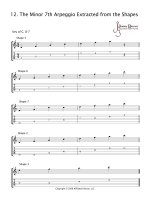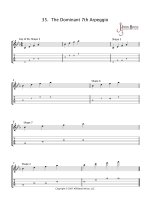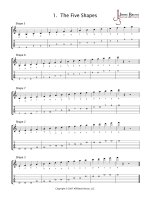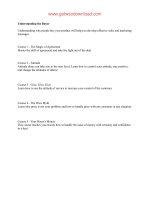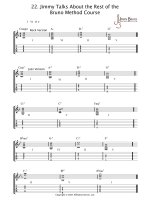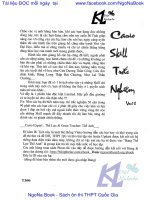making the most of the water tủ tài liệu bách khoa
Bạn đang xem bản rút gọn của tài liệu. Xem và tải ngay bản đầy đủ của tài liệu tại đây (5.12 MB, 297 trang )
EAR797_MAKING_THE_MOST_1.qxd
3/6/09
12:55
Page 1
dimensions: 26mm spine
234x156mm live areas front and back + 3mm (bleed), + 3mm (board allowance) + 15mm (to go under the endpapers)
Demand for water is one of the major challenges of the current century, but past approaches are
no longer sufficient. Based on the ‘soft path’ approach to the energy sector, a transition is now
underway to a soft path for water. This approach starts by ensuring that ecosystem needs for
water are satisfied and then undertakes a radical approach to reducing human uses of water by
economic and social incentives, including open decision making, water markets and equitable
pricing, and the application of super-efficient technology, all applied in ways that avoid jeopardizing
quality of life.
This book is the first to present and apply the water soft path approach. It has three aims: to bring
to a wider audience the concept and the potential of water soft paths; to demonstrate that
soft path analysis is analytical and practical, and not just ‘eco-dreaming’; and to indicate that
soft paths are not only conceptually attractive but that they can be made economically and
politically feasible. These goals are reflected by the scope of the book, which is organized around
the three aspects of any soft path: a vision of a sustainable water future based on the soft path
concept; an analytic method to define alternative routes to get to that future (most literally, the
soft paths), as illustrated by case studies in Canada and elsewhere; and a tool kit for planners
and other practitioners.
Natural Resource Management/Energy/
Sustainable Development
D av i d B . B ro o k s
Oliver M. Brandes
Stephen Gurman
David B. Brooks was Canada’s first Director of Energy Conservation, and later spent 15 years
with IDRC (International Development Research Centre) on overseas projects on energy, water
and natural resource management. He was one of the founders of Friends of the Earth Canada and
now serves as its Senior Advisor – Fresh Water. Oliver M. Brandes is Water Sustainability Project
Leader and Associate Director at the POLIS Project on Ecological Governance, University
of Victoria, Canada. Stephen Gurman is an environmental consultant and writer, based in
Ottawa, Canada.
Making the Most of the Water We Have
‘The book provides a timely review of how political economies worldwide have been introducing
soft path approaches. It is immensely strengthened by authors who introduced the idea to the
water sector and diffused it among water scientists, engineers and planners.’
From the Foreword by Professor J. A. [Tony] Allan, King’s College London and the School of Oriental and
African Studies, University of London, UK
T h e S o f t P a t h A p p r o a c h t o Wa t e r M a n a g e m e n t
‘This book looks ahead to provide the context within which to consider our use and management
of water as we enter an increasingly uncertain future.’
Dr David Suzuki, Professor Emeritus, University of British Columbia, author, broadcaster
Making
the Most
of the Water
We Have
The Soft Path Approach
to Water Management
ISBN: 978-1-844-07754-0
Edited by
www.earthscan.co.uk
Earthscan strives to minimize its impact on the environment
9 781844 077540
David B. Brooks, Oliver M. Brandes and Stephen Gurman
Making the Most of the
Water We Have: The Soft Path
Approach to Water Management
Making the Most of the
Water We Have: The Soft Path
Approach to Water Management
Edited by David B. Brooks, Oliver M. Brandes
and Stephen Gurman
London • Sterling, VA
First published by Earthscan in the UK and USA in 2009
Copyright © David B. Brooks, Oliver M. Brandes and Stephen Gurman, 2009
All rights reserved
ISBN:
978-1-84407-754-0
Typeset by MapSet Ltd, Gateshead, UK
Cover design by Clifford Hayes
For a full list of publications please contact:
Earthscan
Dunstan House
14a St Cross St
London, EC1N 8XA, UK
Tel: +44 (0)20 7841 1930
Fax: +44 (0)20 7242 1474
Email:
Web: www.earthscan.co.uk
22883 Quicksilver Drive, Sterling, VA 20166-2012, USA
Earthscan publishes in association with the International Institute for
Environment and Development
A catalogue record for this book is available from the British Library
Library of Congress Cataloging-in-Publication Data
Making the most of the water we have : the soft path approach to water
management / edited by David B. Brooks, Oliver M. Brandes, and Stephen
Gurman.
p. cm.
Includes bibliographical references and index.
ISBN 978-1-84407-754-0 (hardback)
1. Water resources development–Environmental aspects. 2. Watersupply–Management–Environmental aspects. I. Brooks, David, B., 1934– II.
Brandes, Oliver M., 1972– III. Gurman, Stephen.
TD195.W3M35 2009
363.6'1–dc22
2009005726
At Earthscan we strive to minimize our environmental impacts and carbon
footprint through reducing waste, recycling and offsetting our CO2 emissions,
including those created through publication of this book. For more details of our
environmental policy, see www.earthscan.co.uk.
This book was printed in the UK by
Antony Rowe, Chippenham.
The paper used is FSC certified and the
inks are vegetable based.
I do not know much about gods; but I think that the river
Is a strong brown god – sullen, untamed and intractable,
Patient to some degree, at first recognised as a frontier;
Useful, untrustworthy, as a conveyor of commerce;
Then only a problem confronting the builder of bridges.
The problem once solved, the brown god is almost forgotten
By the dwellers in cities – ever, however, implacable.
Keeping his seasons and rages, destroyer, reminder
Of what men choose to forget. Unhonoured, unpropitiated
By worshippers of the machine, but waiting, watching and waiting…
————The river is within us, the sea is all about us ...
T. S. Eliot, ‘The Dry Salvages’ in Four Quartets, 1941
Contents
List of Figures, Tables and Boxes
List of Contributors
Foreword by Tony Allan
Acknowledgements
List of Acronyms and Abbreviations
ix
xi
xv
xix
xxi
Introduction
1
Why a Water Soft Path, and Why Now
Oliver M. Brandes, David B. Brooks and Stephen Gurman
3
Part I Water Soft Paths as Human Vision
2
Avoiding the Perfect Storm: Weathering Climate Change by
Following its Effects on Water Resources
Robert W. Sandford
23
3
In the Beginning: Soft Energy Paths
Susan Holtz and David B. Brooks
35
4
Getting it Right: Misconceptions About the Soft Path
Peter H. Gleick
49
5
Practising Ecological Governance: The Case for the Soft Path
for Water
Oliver M. Brandes
6
Water Policy: Changing Course for the Soft Path
Susan Holtz
61
73
Part II Water Soft Paths as Analytical Method
7
Getting Quantitative: The Canadian Water Soft Path Studies
David B. Brooks and Susan Holtz
85
8
Turning Principles into Practice: The WSP Scenario Builder
Carol Maas and Tony Maas
101
viii
9
10
11
MAKING THE MOST OF THE WATER WE HAVE
Thinking Beyond Pipes and Pumps: Water Soft Paths at the
Urban Scale
Oliver M. Brandes and Tony Maas
113
Focusing on Geographic Boundaries: Water Soft Paths at the
Watershed Scale
Lisa Isaacman and Graham R. Daborn
123
Focusing on Political Boundaries: Water Soft Paths at the
Provincial Scale
Paul Kay and Elizabeth Hendriks
133
Part III Water Soft Paths as Planning Tool
12
13
Removing Institutional Barriers to Water Soft Paths:
Challenges and Opportunities
Sarah Jordaan, Carla Stevens and David B. Brooks
147
Pushing the Boundaries: Shifting Water Soft Paths Philosophy
towards Hard Policy in Municipal Water Management
Sarah E. Wolfe and Kurtis Elton
163
14
Green Buildings and Urban Space: A Water Soft Path Perspective
Andrew Hellebust
181
15
Water Soft Path Thinking in the United States
Peter H. Gleick
195
16
Water Soft Path Thinking in Other Developed Economies
Editor’s Note
A England – Gareth Walker
B The European Union – Simone Klawitter
C Australia – Henning Bjornland and Geoff Kuehne
205
205
206
211
218
17
Water Soft Path Thinking in Developing Countries
Editor’s Note
A South Africa – Inga Jacobs and Anthony Turton
B India – Sara Ahmed
C Middle East and North Africa – David B. Brooks
227
227
228
234
242
Conclusion
18
A Water Future Different from the Past
David B. Brooks, Oliver M. Brandes and Stephen Gurman
255
Annex – How To Create A Soft Path Plan For Water
David B. Brooks and Oliver M. Brandes with Carol Maas,
Susanne Porter-Bopp and Jennifer Wong
263
Index
267
List of Figures, Tables and Boxes
Figures
1.1
4.1
7.1
8.1
8.2
8.3
8.4
9.1
10.1
10.2
10.3
10.4
11.1
13.1
15.1
15.2
16.1
16.2
16.3
Planning for the future with a soft path approach
Projected and actual global water withdrawals
Production possibilities graph
WSP conceptual graph
Flow diagram of WSP Scenario Builder logic
The disaggregation process in the Scenario Builder
Residential sector sheet illustrating the suite of measures, and the
penetration rates for each scenario
Summary of water use in various soft path scenarios for a
generic urban region in 2050
Watersheds of the Annapolis Valley, Nova Scotia
Annual water withdrawal by sector
Summer water withdrawal by sector
Annual water demand by sector in the Annapolis Valley under
BAU, Demand Management and WSP scenarios
Comparison of Ontario’s water consumption in 2031 under three
different scenarios
The four elements of social capital
US economic productivity of water 1950–2000 in dollars (1996)
of GNP per cubic metre of water used
US GDP and water withdrawals, 1900–2000
Licensed withdrawals: England and Wales
Deadlines related to the implementation of the economic elements
of WFD
General principles of full cost of water
9
54
91
102
104
106
108
119
124
127
127
128
141
167
197
201
207
214
215
Tables
9.1
Summary of water use in various soft path scenarios for a generic
urban region in 2050
10.1 Mean surface and groundwater base supply, ecological
requirements and availability
119
126
x
MAKING THE MOST OF THE WATER WE HAVE
10.2 Considerations for selecting appropriate sector-specific
reduction measures
11.1 Estimated water intake and consumption, Mm3/yr, by
manufacturing categories in Ontario for 1996
130
139
Boxes
1.1
1.2
4.1
5.1
13.1
13.2
13.3
13.4
15.1
16.1
The problem
Spectrum of water management
Perennial cost overruns on the hard path
Ecological governance in a nutshell
‘Get Water Smart’, Kelowna, BC
Capital Regional District Water Services demand management
programme
Early adopters in Canada: Guelph, Ontario
Long-term integrated conservation in the town of Okotoks,
Alberta
Some key elements of integrated water management plans
The European Water Framework Directive
6
9
56
64
169
170
173
174
200
213
List of Contributors
Editors
Oliver M. Brandes is a political ecologist who serves as Associate Director for
the University of Victoria’s POLIS Project on Ecological Governance. He has a
background in law, economics and ecological restoration, and leads the POLIS
Water Sustainability Project. His work focuses on practical aspects of sustainable water resource management and ecologically based legal and institutional
reform:
David B. Brooks, who was educated in geology and economics, retired several
years ago after 14 years with Canada’s International Development Research
Centre. He now serves as Senior Advisor – Fresh Water for Friends of the Earth
– Canada. His main research interests lie in the linkages between environmental protection, on the one hand, and the use of minerals, energy and water, on
the other:
Stephen Gurman is a consultant with experience in environment and development, project management, community development and communications. He
has worked with Canadian and international NGOs, CIDA and Industry
Canada and spent five years in Africa with a Canadian volunteer-sending
organization. Stephen has a Mechanical Engineering degree from McGill
University (1972):
Contributing authors
Sara Ahmed has been working on the political economy of water in India for
the past 20 years. After obtaining her PhD from Cambridge University (1991),
Sara taught at the Institute of Rural Management, Anand, India. She is
currently working with IDRC, New Delhi, and her primary responsibility will
be to develop, with her team, a research programme for South Asia that
addresses critical questions of food and water security in the context of climate
change, adaptation and growing conflict:
Henning Bjornland holds two academic positions; he is a Canada Research
Chair in Water and the Economy – International at University of Lethbridge,
Alberta, Canada and an Associate Research Professor at the University of
xii
MAKING THE MOST OF THE WATER WE HAVE
South Australia. He has researched water management and policy issues in
Australia since 1993 and in Canada since 2005:
Graham Daborn was Professor of Biology at Acadia University and the first
Director of the Arthur Irving Academy for the Environment. Previously
(1984–2004) he was the Director of the Acadia Centre for Estuarine Research.
He is currently co-chair of the Program Management Committee for the
Canadian Water Network:
Kurtis Elton holds a Bachelor of Arts & Science from McGill University, where
he majored in chemistry. He is currently studying at the University of Waterloo
as a Master’s candidate in the Faculty of Environment, and enjoys drawing
cerebral comics for the school’s newspaper:
Peter H. Gleick is co-founder and president of the Pacific Institute for Studies
in Development, Environment, and Security in Oakland, California. His
research and writing address the critical connections between water and
human health, the hydrologic impacts of climate change, sustainable water use,
privatization and globalization, and international conflicts over water
resources. He was named a MacArthur Fellow in October 2003 and was
elected to the US National Academy of Sciences:
Andrew Hellebust, P.Eng., received training in chemical engineering and
biology at the Bachelor’s level at the University of Toronto and at the Master’s
level at Princeton University. Since 1994, he has worked in the field of smallscale and decentralized water and wastewater treatment and is president of
Rivercourt Engineering Inc. He balances consulting, design and research in his
practice and is a research associate with the Centre for Alternative Wastewater
Treatment at Fleming College, Lindsay, Ontario:
Elizabeth Hendriks completed a Masters in Environment Studies from the
University of Waterloo during which she received a Water Policy Fellowship
from the Walter and Duncan Gordon Foundation. She is currently a
research associate managing a two-year research project on the role of
residential home builders in the uptake of water efficiency innovation:
Susan Holtz currently works with the Canadian Institute for Environmental
Law and Policy as senior policy analyst. She has done projects on many aspects
of energy, environment and sustainable development, including being one of
the Canadian soft energy path analysts, as well as part of the Canadian water
soft path study team:
Lisa Isaacman is a conservation scientist with a Bachelors of Science in
Environmental Sciences from the University of Guelph and a Masters of
Environmental Studies from Dalhousie University. Her diverse areas of interest
include habitat and wildlife protection, environmental policy and stewardship:
LIST OF CONTRIBUTORS
xiii
Inga Jacobs is a Researcher in the Water Governance Systems Research Group
at the Council for Scientific and Industrial Research in South Africa. She is
currently completing her PhD at the School of International Relations,
University of St Andrews, Scotland in Transboundary Cooperative
Management and Water Politics in Africa:
Sarah Jordaan is a PhD candidate at the University of Calgary in both Energy
and Environmental Systems and Environmental Design. Her first degree was in
Physics from Memorial University of Newfoundland. Her research interests lie
in assessing land use of energy developments from a life cycle perspective:
Paul Kay is Chair, Department of Environment and Resource Studies,
University of Waterloo. Since his PhD (Geography, University of WisconsinMadison), he has studied climatic variability and water resources from a
variety of angles in a variety of settings:
Simone Klawitter has more than 10 years experience with governmental and
non-governmental water agencies, as policy advisor, consultant and academic.
She specializes in water economics with focus on water pricing, utility regulation, institutional development, and innovative financing instruments. After
many years in the Middle East she now works as financial advisor in Southern
Africa on behalf of the German Development Cooperation. She has studied
physics and law and holds a PhD in economics:
Geoff Kuehne has had a 25-year career as a wheat/sheep farmer in South
Australia. After selling his farm in 2000, he completed an MBA, and then a
PhD researching irrigators’ management behaviour. His research interest
focuses on identifying and exploring how farmers’ non-profit-maximizing
values influence their behaviour:
Carol Maas is the Director of Innovation for the POLIS Water Sustainability
Project and is the primary investigator for the water–energy nexus research
theme. She is a professional engineer with 10 years of water and wastewater
engineering background, including consulting, R&D and process engineering:
Tony Maas is Senior Freshwater Policy Advisor with World Wildlife Fund –
Canada. Prior to joining WWF, Tony worked extensively on developing the
water soft path concept with the University of Victoria’s POLIS Project on
Ecological Governance. He has studied Environmental Science at Royal Roads
University in Victoria and Water Governance at the University of Waterloo.
Robert Sandford is the Chair of the Canadian Partnership Initiative in support
of the United Nations International ‘Water for Life’ Decade; a member of the
Advisory Committee for the Rosenberg International Forum on Water Policy;
and Director of the Western Watersheds Climate Research Collaborative, a
xiv
MAKING THE MOST OF THE WATER WE HAVE
research and public policy consortium of universities, research institutions and
government agencies involved in water and water-related climate research in
the river basins that originate in Canada’s western mountains:
Carla Stevens specializes in integrated land use and watershed management.
She has worked in the non-government, provincial government and private
sectors in Canada. Her research and work experience in alternative approaches
to watershed management led to her desire to address the challenges of implementing innovative water management policy:
Anthony Turton is a water resource specialist focusing on water and human
health risks from radionuclide and heavy metal contamination from the gold
mining industry in South Africa. He is a Director of TouchStone Resources
(Pty) Ltd that works at the interface between new water, new energy and socioeconomic development:
Gareth Walker holds a BSc in Physics and an MSc in Water Science and Policy.
He is currently a research associate with Waterwise, an independent nongovernmental organization with a remit to reduce water consumption within
the UK. Past work has included developing Waterwise policy on water affordability and economic incentives for efficiency. His current focus is on the water,
energy and carbon relationships in domestic consumption:
Sarah E. Wolfe is an Assistant Professor in the Department of Environment and
Resource Studies at the University of Waterloo, Canada. Her doctoral research
examined the interplay between social networks, knowledge and water
demand management in southern Africa and Canada (Ontario). Sarah’s
current research examines tacit knowledge and water efficiency innovations in
the residential building sector; upcoming research will explore the gender
dimensions of Canadian water policy.
Foreword
Soft Path Approach in Water Resources Management and
Policy Reform
Water users and water managers need all the help they can get if they are to
avoid destroying the capacity of our water environments to provide secure
water services. As we begin a new century, after nearly 150 years of ‘modern’
water engineering efforts, major flaws are beginning to appear in what has
seemed a water management success story. Today’s populations and their water
consuming ways are exerting unprecedented pressures on the world’s surface
and groundwater resources. Society and its political leaders obstinately refuse
to engage effectively with the dangers resulting from the rising trend in collective global water consumption. We are still living with our beliefs and biases
that water should be free in our homes and, where possible, for our livelihoods.
Our startling lack of response to the dangers that face us seems to indicate that
we are ill-equipped to evaluate risks of the type and scale that human demands
are placing on our environment. ‘It is a miracle that we get anything right’
(Ferguson, 2009). The analysis of approaches to managing water resources in
this useful book highlights the risks of our water consuming ways. It emphasizes the role of human behaviour in overusing and spoiling the diminishing
supply of fresh water resources upon which we all depend, and, per contra,
how human ingenuity can get us out of the trap we have built for ourselves.
Demand management is one dimension of the rich soft path approach.
Demand management policies and demand management practices address the
issue of water use efficiency – more output per drop and more jobs per drop.
They promote measures that achieve technical and economic efficiency by
improving the returns to water from investing in technologies that increase
efficiency and reduce waste. Water efficiency can be doubled and water pollution significantly reduced by technically efficient measures.
Still more powerful is the soft path approach of allocative efficiency. This
approach has vastly more potential to increase returns to water than the hard
path technical approaches. However, experience shows that, though the soft
approach is economically rational, it is also politically contentious. The soft
path approach requires that water users change the way they use and manage
water. At home people can shower rather than bathe, remove thirsty plants
from the garden, cease watering the garden altogether and generally use water
xvi
MAKING THE MOST OF THE WATER WE HAVE
more carefully. They can be given incentives to use less by being charged higher
prices for metered water. But while introducing properly maintained water
metering and billing systems always induces a modest reduction in use, users
do not welcome them. Politicians are predictably wary of such reforms.
The forces that have put the hard path approaches in place are deeply
entrenched – professionally, institutionally and politically. It has been difficult
for soft path approaches to make inroads as they are often associated with
unpopular changes in the ways of using water. Unpopular measures incur political prices. Invisible, ‘politics-lite’ soft path policies and practice have been
adopted much more readily – if unconsciously. They have been very effective in
the second half of the 20th century in improving returns to water. They have
been much more significant than consciously deployed soft path measures.
The soft path approaches that have reallocated water from low return to
high return activities – from low-value to high-value crop production and from
relatively low-value irrigation to very high-value industries and services – have
had unintended consequences. Of course, they have had efficiency impacts.
Even more important they have brought water and food security to regions
that are seriously water scarce. Water reallocated in diversifying industrial
economies enables the water scarce to trade their way to water and food
security. Singapore, Israel and Malta are examples. Invisibly and silently, and
without destabilizing political conflicts, economic diversification reallocated
water to activities and sectors that brought very high returns to scarce water.
But soft path approaches are not just about economic efficiency and
improving economic returns to water. As Canadian author Margaret Atwood
emphasizes, ‘The economy is a wholly owned subsidiary of the environment.’
The soft path approach is not just about more crop and jobs per drop. It also
addresses the issues of the sustainable management of water. More care per
drop is also a high priority as it prevents the irreversible impairment of surface
water and groundwater. The soft path approach also recognizes the
water–energy nexus. This nexus is associated with three weddings and avoiding two funerals. The weddings are first, the production of clean energy from
water; second, the production of usable water with clean energy; and third, the
extraordinary role of economic diversification, socio-economic development
and trade in enabling environments and economies to be sustainable. The first
funeral to be avoided is the destruction of the atmosphere through the profligate use of fossil energy; the second is avoiding serious impairment of the
aquatic environment as a consequence of using it as a sink for industrial and
agricultural pollution.
The book provides a timely review of how political economies worldwide
have been introducing soft path approaches. It is immensely strengthened by
authors who introduced the idea to the water sector and diffused it among
water scientists, engineers and planners. Many of them have written chapters
in this book.
The term soft path has proved to be a sticky idea that has begun to gain
currency. For those managing water and engaging in its contentious allocative
FOREWORD
xvii
politics, the term draws attention to the existence of alternatives to the familiar
supply-side approaches. The soft path approach is intuitively holistic and
requires that water users as well as water professionals be informed and
engaged with the ecology of water and with the multiplicity of stakeholders
who use water. It is precautionary because it helps society avoid the funerals of
the degraded water environment and of the poisoned atmosphere by recognizing the air/water/energy nexus. Finally, the soft path approach is timely and
appropriate in that it fosters the good governance of water in ways that
constructively engage the social solidarities involved in the use and management of water.
Professor Tony Allan
King’s College London and the School of Oriental and African Studies,
University of London, UK
References
Ferguson, N. (2009) ‘This much I know’, The Observer Magazine, 18 January, p10
Acknowledgements
This book began as a series of conversations in 2003 about how environmental
non-governmental groups might expand the typically constrained discussion
about water policy to a more holistic alternative. A clear recurring theme in the
discussions was a belief that by putting emphasis on why we were using so
much water as opposed to how we might use it better might provide a real
opportunity to create a more sustainable future. The issues centred on the
human role in choosing how to use water instead of just on the technologies we
had come to depend upon. Several people, including Peter Gleick in the United
States and Harry Swain in Canada suggested that we adapt Amory Lovins’ soft
energy path to fresh water. Early work was done at Friends of the Earth –
Canada in collaboration with Gregory Rose, Rob de Loë, Robert Patrick and,
more generally on water sustainability, with Keith Ferguson and Michael
M’Gonigle at the University of Victoria’s POLIS Project on Ecological
Governance. Initial support for an in-depth analysis of soft path applications in
Canada was arranged by Jennifer Moore in Environment Canada and later by
the ongoing and even courageous support of Brenda Lucas at the Gordon
Foundation. Though not directly related to the production of this book, they
all deserve some credit for the material that appears in it.
The book itself also has had significant support from a variety of people
not only providing research and design and technical support, but also review,
encouragement and development of ideas and concepts through thoughtful
discussion, including notably Rod Dobell, Susanne Porter-Bopp, Ellen
Reynolds, Ray Travers, Jennifer Wong and Ann Zurbrigg at the University of
Victoria’s POLIS Project for Ecological Governance. Nicola Ross and Marcia
Ruby were critical in arranging initial publication of our research results in the
July 2007 issue (vol 33, no 4) of the Canadian environmental journal,
Alternatives, and also granted permission for us to use some figures that were
originally prepared for that issue. Beatrice Olivastri and Karen Cartier at
Friends of the Earth – Canada provided ongoing support throughout the whole
process from tentative explorations to completion of the manuscript. Tim
Morris at the Gordon Foundation provided funding for a mid-project meeting
of the three editors at the offices of the Foundation in Toronto. Others who
were involved with preparation of material leading up the book included Lynn
Barber, Matt Binstock, Anja Grauenhorst, Alina Michalska and Nabeela
xx
MAKING THE MOST OF THE WATER WE HAVE
Rahman. For suggesting Canadian poems from which to select quotations, we
thank Toby Brooks and Sheila Forsyth.
Our long-time colleague Diane Beckett deserves special thanks for taking
on the task of reading the whole text through and getting her overall review
and comments back to us in the shortest possible time.
House of Anansi Press kindly gave us permission to use material in Chapter
3 that had previously been published in an article by Susan Holtz and David
Brooks entitled ‘Reverse Engineering: Soft Energy Paths’ in the 2003 book,
Fueling the Future: How the Battle Over Energy is Changing Everything. The
journal Water International gave us permission to use material in Chapter 7
that had previously been submitted to the journal for publication as an article
by David Brooks and Susan Holtz. Finally, we express our thanks to Tim
Hardwick at Earthscan for his general monitoring of our process through to
publication, and for patiently answering our interminable series of questions
about format.
David B. Brooks, Oliver M. Brandes and Stephen Gurman
List of Acronyms and
Abbreviations
ALUS
BAU
CAWP
CMA
CMHC
CoAG
CRD
CSIR
CSIRO
Alternative Land Use Services
business as usual
Coalition Against Water Privatisation (South Africa)
Catchment Management Agency
Canada Mortgage and Housing Corporation
Council of Australian Governments
Capital Regional District
Council for Scientific and Industrial Research (South Africa)
Commonwealth Scientific and Industrial Research
Organisation
CWWA-WEN Canadian Water and Wastewater Association’s Water
Efficiency Network
Defra
Department for Food, Environment and Rural Affairs
DWAF
Department of Water Affairs and Forestry ( South Africa)
DWI
Drinking Water Inspectorate
EA
Environment Agency
EEB
European Environmental Bureau
ELV
Emission Limited Values
ENGOs
environmental non-government organizations
EQS
Environmental Quality Standards
ERR
Earthquake Reconstruction and Rehabilitation
EU
European Union
FCM
Federation of Canadian Municipalities
GDP
gross domestic product
GLC
Great Lakes Commission
GLSLRB
Great Lakes–St Lawrence River Basin
GMID
Goulburn-Murray Irrigation District
GNP
gross national product
GVRD
Greater Vancouver Regional District
GWP
Global Water Partnership
GWSSB
Gujarat Water Supply and Sewerage Board
IDRC
International Development Research Centre (Ottawa)
xxii
MAKING THE MOST OF THE WATER WE HAVE
IJC
IWRM
LCA
LCD
MDB
MDBMC
MENA
Mm3
NGOs
NRTEE
NWI
O&M
OECD
Ofwat
OPEC
RMI
RSC
SOPPECOM
SPA
THM
TISS
UN
UNDP
UNESCO
WAGRICO
WASMO
WDM
WEDO
WEPs
WFD
WHO
WMAs
WRI
WRPC
WSEP
WSP
WUAs
International Joint Commission
Integrated Water Resources Management
life cycle assessment
litres per capita-day
Murray-Darling Basin
Murray-Darling Basin Ministerial Council
Middle East and North Africa
million cubic metres
non-governmental organizations
National Round Table on the Environment and the Economy
National Water Initiative (CoAG)
operations and maintenance
Organisation for Economic Co-operation and Development
Water Services Regulatory Authority
Organization of Petroleum Exporting Countries
Rocky Mountain Institute
rural service council (South Africa)
Society for Promoting Participative Ecosystem Management
(Pune)
soft path analysis
trihalomethanes
Tata Institute of Social Studies (Mumbai)
United Nations
United Nations Development Programme
United Nations Educational, Social and Cultural Organization
Water Resources Management in Cooperation with
Agriculture project
Water and Sanitation Management Organisation (India)
water demand management
Women’s Environment and Development Organization
Water Efficiency Plans/Policies
Water Framework Directive (EU)
World Health Organization
water management areas
World Resources Institute
Water Resources Policy Commissions
Water Strategy Expert Panel
water soft paths
water user associations
Introduction
